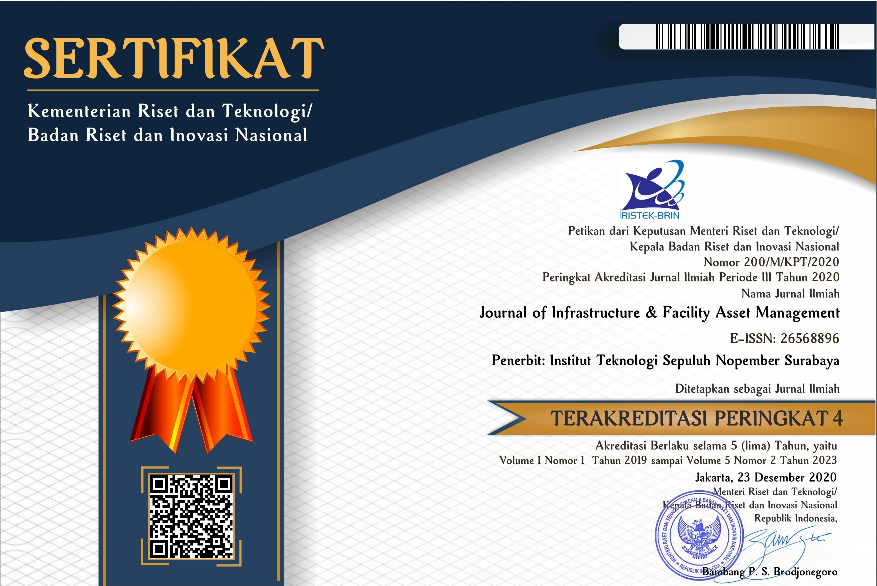A New Approach to Estimate the Potential Assets Loss due to Dam-Break Event in Indonesia
Abstract
A dam break is a devastating natural catastrophe that can lead to huge losses. In general, the severity of a disaster can be determined by the amount of damage it causes. The greater the loss, the more severe the disaster and vice versa. However, determining the potential asset loss as a result of a disaster is a challenging task. So far, there is no method for calculating potential asset loss that is specifically made for dam-break disasters. Therefore, this study proposes a new approach in calculating the potential asset loss for a dam-break. In this study, the potential asset loss is calculated by considering four factors, namely the Potential Loss of Lives (PLOL), Potential Loss of Incomes (PLOI), Potential Loss of Houses Damage (PLOHD), and Potential Loss of Productive Land (PLOPL). In addition, the study calculates the potential asset loss of the Ketro Dam dam-break disaster. Based on the evaluation results, the PLOL might reach Rp. 26,419,715,661. PLOI might reach maximum value of Rp. 1,185,600,000. PLOHD might reach maximum value of Rp. 4,255,325,000. And lastly , PLOPL might reach maximum value of Rp. 25,375,080,780. Thus, the potential asset loss for the Ketro Dam dam-break disaster based on the analysis can reach Rp. 57,235,721,441 or USD 4,026,304.
Full Text:
PDFReferences
Ariq, M., Khairi, F., Suprijanto, H., & Hendrawan, P. (2021). "Analisis Keruntuhan Bendungan Rukoh Kabupaten Pidie Menggunakan Aplikasi HEC-RAS dan Berbasis". InaSAFE. 2(1), 55–66.
BPBD Kota Makassar. (2019). Case Study : InaSAFE for Flood Contingency Plan Development in Makassar City , South Sulawesi. In InaSAFE Use Cases.
Campbell, T. (2019). Nebraska’s Spencer Dam will not be rebuilt in wake of historic 2019 flood. https://www.1011now.com/2021/05/05/nebraskas-spencer-dam-will-not-be-rebuilt-in-wake-of-2019-historic-flood/
Ennes, J. (2021). After two collapses, a third Vale dam at ‘imminent risk of rupture.’ https://news.mongabay.com/2021/06/after-two-collapses-a-third-vale-dam-at-imminent-risk-of-rupture/
Faturahman, B. M. (2018). Konseptualisasi mitigasi bencana melalui perspektif kebijakan publik. Jurnal Ilmu Administrasi Publik Unmer, 8(5), 55.
Ginting, B. M. (2017). A two-dimensional artificial viscosity technique for modelling discontinuity in shallow water flows. Applied Mathematical Modelling, 45, 653–683. https://doi.org/10.1016/J.APM.2017.01.013
Ginting, B. M. (2019a). Efficient Parallel Simulations of Flood Propagation Including Wet-Dry Problems.
Ginting, B. M. (2019b). Central-upwind scheme for 2D turbulent shallow flows using high-resolution meshes with scalable wall functions. Computers & Fluids, 179, 394–421. https://doi.org/10.1016/J.COMPFLUID.2018.11.014.
Ginting, B. M., Bhola, P. K., Ertl, C., Mundani, R.-P., Disse, M., & Rank, E. (2020). Hybrid-Parallel Simulations and Visualisations of Real Flood and Tsunami Events Using Unstructured Meshes on High-Performance Cluster Systems. In P. Gourbesville & G.
Caignaert (Eds.), Advances in Hydroinformatics (pp. 867–888). Springer Singapore.
Ginting, B. M., & Ginting, H. (2020). Extension of artificial viscosity technique for solving 2D non-hydrostatic shallow water equations. European Journal of Mechanics - B/Fluids, 80, 92–111. https://doi.org/10.1016/J.EUROMECHFLU.2019.12.002.
Ginting, B. M., & Mundani, R.-P. (2019)." Comparison of Shallow Water Solvers: Applications for Dam-Break and Tsunami Cases with Reordering Strategy for Efficient Vectorization on Modern Hardware". Water, 11(4). https://doi.org/10.3390/w11040639.
Ginting, B. M., Mundani, R.-P., & Rank, E. (2018). "Parallel Simulations of Shallow Water Solvers for Modelling Overland Flows". HIC 2018. 13th International Conference on Hydroinformatics, 2018. https://easychair.org/publications/paper/Lv4S.
Ginting, B., & Mundani, R.-P. (2018). Artificial Viscosity Technique: A Riemann-Solver-Free Method for 2D Urban Flood Modelling on Complex Topography. https://doi.org/10.1007/978-981-10-7218-5_4.
Hattum, K. C. van, de Ruig, L. T., Bos, M. F. M., Kind, J., & de Moel, H. (2020). "Shifting away from asset damage and toward well-being loss within flood risk management". FLOODrisk 2020 – 4th European Conference on Flood Risk Management Figure.
Hayes, J. (2021). One Year After the Edenville Dam Failure – Mackinac Center. https://www.mackinac.org/one-year-after-the-edenville-dam-failure
Huaizhi, S. U., Jiang, H. U., & Zhongru, W. U. (2012). "A study of safety evaluation and early-warning method for dam global behavior". Structural Health Monitoring, 11(3), 269–279. https://doi.org/10.1177/1475921711419993
Huizinga, J., de Moel, H., & Szewczyk, W. (2017). Global flood depth-damage functions. In Joint Research Centre (JRC). https://doi.org/10.2760/16510
Hutauruk, T. R., Kusuma, A. R., & Ningsih, W. (2020). Karang Mumus Kota Samarinda ( Estimation of Economic Damages Due To Floods on Residential Areas Around Karang Mumus River in Samarinda ). 2, 47–59.
Jayantara, I. (2020). "Implementasi Qgis Untuk Mengestimasi Kerugian Ekonomi Akibat Banjir Di Kabupaten Bandung". Jurnal Pendidikan Teknologi Dan Kejuruan, 18(2), 231–242. https://ejournal.undiksha.ac.id/index.php/JPTK/article/view/25839
Minola, G. B., & Herli, G. (2019). "Hybrid Artificial Viscosity–Central-Upwind Scheme for Recirculating Turbulent Shallow Water Flows". Journal of Hydraulic Engineering, 145(12), 4019041. https://doi.org/10.1061/(ASCE)HY.1943-7900.0001639
Muin, S., Boer, R., & Suharnoto, Y. (2015). "Pemodelan Banjir dan Analisis Kerugian Akibat Bencana Banjir di DAS Citarum Hulu". Jurnal Tanah Dan Iklim, 39(2), 75–84. https://doi.org/10.2017/jti.v39i2.6224
Nurdin, M. F. (2018). Estimasi nilai kerugian ekonomi akibat banjir bandang di Garut tahun 2016. 1759.
Prayoga, I. S. (2020). Curah Hujan Ekstrem Menggunakan Extreme Value Theory Dan Copula.
PT Metanna Engineering. (2020a). Laporan Pendahuluan : Persiapan dan penetapan ijin operasi Bendungan Cengklik, Ketro, dan Delingan serta uji model fisik Bendungan Pacal.
PT Metanna Engineering. (2020b). Laporan survey Sosial Ekonomi Bendungan Ketro.
Ratnagiri. (2019). Tiware Dam breach: 4 still missing as search operation enters fifth day. https://www.indiatoday.in/india/story/tiware-dam-breach-4-still-search-operation-fifth-day-1563815-2019-07-07
Sesunan, D. (2014). Analisis Kerugian Akibat Banjir Di Bandar Lampung. Warta LPM, 5(1), 559–584.
Sun, R., Wang, X., Zhou, Z., Ao, X., Sun, X., & Song, M. (2014). "Study of the comprehensive risk analysis of dam-break flooding based on the numerical simulation of flood routing. Part I: Model development". Natural Hazards, 73(3), 1547–1568. https://doi.org/10.1007/s11069-014-1154-z
Suprayitno, H. & Soemitro, R.A.A. (2018). "Preliminary Reflexion on Basic Principle of Infrastructure Asset Management". Jurnal Manajemen Aset Infrastruktur & Fasilitas - JMAIF 2(1) Maret 2018.
Wismana Putra, I. S., Hermawan, F., & Dwi Hatmoko, J. U. (2020). "Penilaian Kerusakan Dan Kerugian Infrastruktur Publik Akibat Dampak Bencana Banjir Di Kota Semarang". Wahana Teknik Sipil: Jurnal Pengembangan Teknik Sipil, 25(2), 86. https://doi.org/10.32497/wahanats.v25i2.2154
DOI: http://dx.doi.org/10.12962%2Fjifam.v4i1.14287
Refbacks
- There are currently no refbacks.
Visitor :
Flag Counter

Journal Of Infrastructure & Facility Asset Management by Institut Teknologi Sepuluh Nopember is licensed under a Creative Commons Attribution-ShareAlike 4.0 International License.





